Statement on Monetary Policy – February 2019 3. Domestic Financial Conditions
Domestic financial conditions continue to be accommodative for most households and large businesses. Financial market prices suggest that the cash rate is expected to remain unchanged over the months ahead, with some expectation of a decrease by later this year. Money market interest rates have remained higher than they were a year ago. While funding costs for banks increased a little since then, they are still at low levels. Housing and business interest rates have increased slightly since mid last year, but are low by historical standards. Growth in housing credit has slowed, which is broadly consistent with weaker demand from investors and the decline in dwelling prices in Sydney and Melbourne. Credit conditions for housing and small business have been tighter than they have been for some time and there are some concerns that a cautious approach by lenders may be affecting some lending decisions. In contrast, growth in business credit has picked up, driven by lending to large businesses, with contributions from both foreign banks and larger Australian banks. In line with international markets, the Australian equity market has been more volatile in recent months, but prices have bounced back from their lows late last year. The Australian dollar remains within its narrow range of recent years.
Investors expect the cash rate to remain unchanged over the next few months
The Reserve Bank has maintained the cash rate target at 1.5 per cent since August 2016. Financial market prices imply that the cash rate is expected to remain unchanged over the next few months, with some expectation of a decrease by later this year (Graph 3.1).
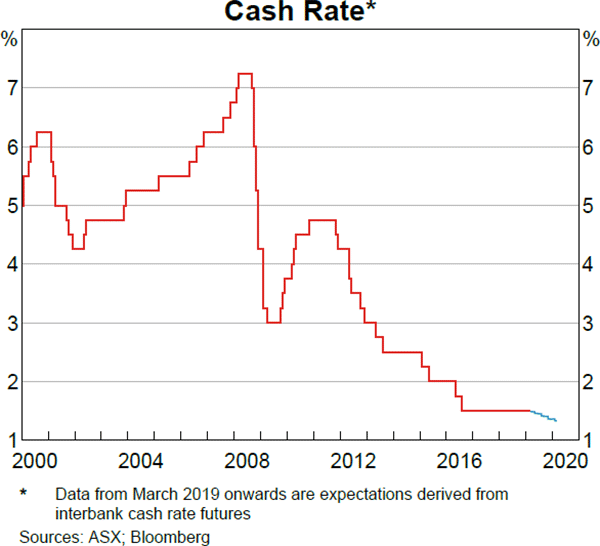
Government bond yields have declined
Yields on 10-year Australian Government Securities (AGS) have declined by around 50 basis points over recent months, to be around 2.15 per cent. This has been broadly in line with the decline in US Treasury yields, with the difference between US Treasury and AGS yields remaining around 50 basis points (Graph 3.2). The pace of net issuance by the Australian Government is expected to decline over 2019, reflecting the narrowing in the forecast budget deficit.
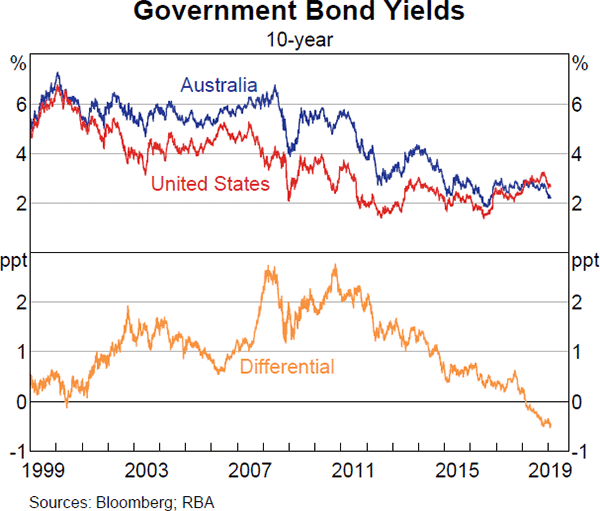
Short-term money market rates remain higher than a year ago
The higher spreads and increased volatility in money markets over the past year continue to reflect structural developments, including banks supplying less liquidity in these markets. This is, in part, the consequence of changes in banking regulation and a lower risk appetite of banks following the global financial crisis. At the same time, the demand for Australian dollar funding in money markets has been relatively strong.
Interest rates in bank bill, repurchase agreement (repo) and foreign exchange swap markets rose towards the end of the December quarter (Graph 3.3). Rates have eased back somewhat in all three markets. The spread of rates on 3-month bank bills relative to overnight indexed swaps (OIS) is around 55 basis points. Spreads on 3- and 6-month bank bills relative to OIS are currently around 30 basis points higher than their average level over 2017. According to liaison with market participants, liquidity conditions in the bank bill market have not changed significantly in recent months and the elevated levels of BBSW rates reflect developments in offshore funding markets for the banks, as well as the repo market. The cost of raising US dollar funding and then converting these funds into Australian dollars in the foreign exchange swap market also rose in December, peaking at around 80 basis points over OIS, before declining modestly. Repo rates increased to 90 basis points over OIS into the end of 2018, and are currently around 55 basis points over OIS as demand for secured funding remains robust, particularly from offshore borrowers. Meanwhile, the cash rate has continued to trade at the Reserve Bank Board's target.
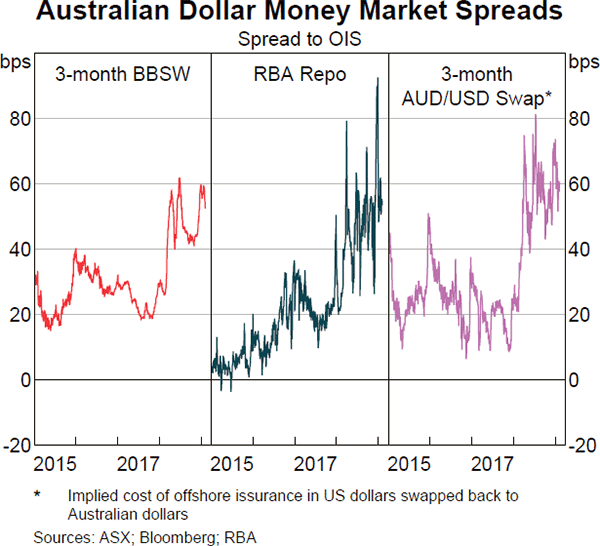
Banks' funding costs are a little higher than in recent years but remain low
There has been some upward pressure on banks' funding costs over the past year reflecting movements in short-term money markets (Graph 3.4). Nevertheless, while banks' funding costs are a little higher than they were in 2017, they remain low by historical standards. Banks' funding costs have increased by less than money market rates since interest rates on retail deposits – which account for around one-third of banks' debt funding – declined over the same period (Graph 3.5). This largely reflected a decline in the interest rates on online saver accounts.
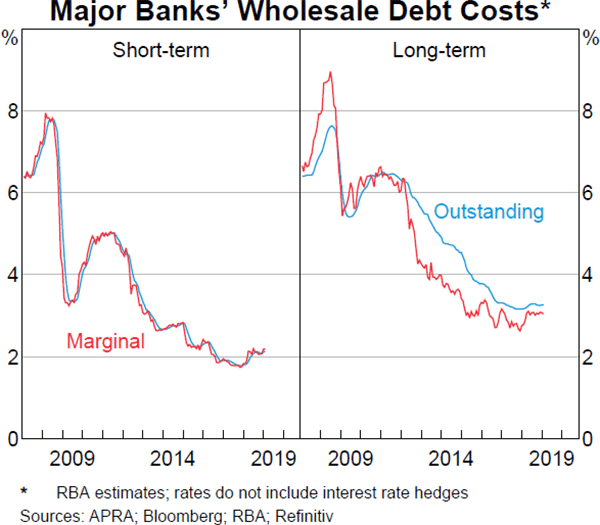
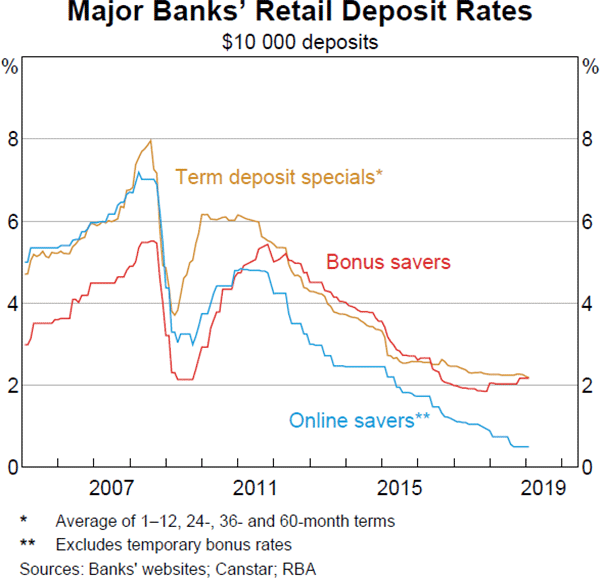
Banks continue to issue wholesale debt at relatively low yields
Australian banks issued bonds at a similar pace to previous years, with around $115 billion of bonds issued in 2018. Net issuance, which takes into account bond maturities, was well above average over 2018, with issuance outpacing scheduled maturities by around $25 billion. A greater volume of bond maturities is scheduled in 2019 (Graph 3.6). While the majority of the banks' long-term wholesale debt funding has typically been raised in offshore markets, the second half of 2018 saw a slightly lower share of offshore issuance than in previous years. Bank bond issuance has remained robust in early 2019 despite an increase in spreads over recent months.
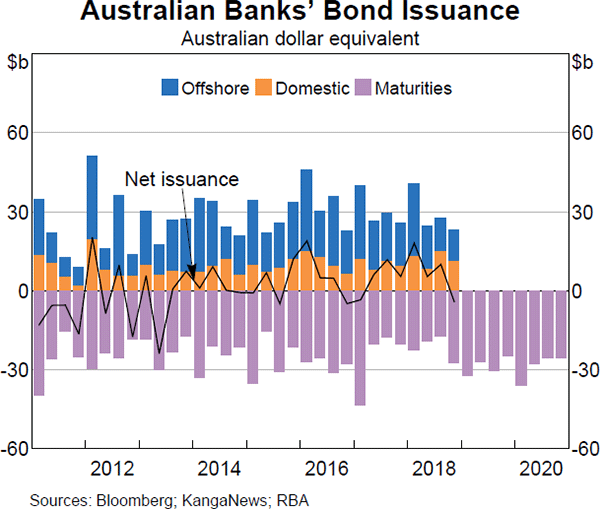
The spreads of major bank bond yields to reference rates increased over 2018, with secondary market spreads on 3-year bonds issued in the Australian market now around 30 basis points wider than the narrow spreads seen in early 2018 (Graph 3.7). The recent increase in spreads is broadly in line with the general rise in bank bond spreads across other advanced economies. Notwithstanding these increases, spreads on Australian bank bonds remain below the levels seen in early 2016, and yields have been little changed at very low levels for four years or so.
Turning to other wholesale funding sources, Australian banks issued around $6.5 billion of Tier 1 capital instruments and $4 billion of Tier 2 capital instruments last year. These wholesale funding sources also count towards regulatory capital for prudential purposes. Late in 2018, the Australian Prudential Regulation Authority (APRA) announced plans to implement a loss-absorbing capacity regime in Australia by 2023.[1]
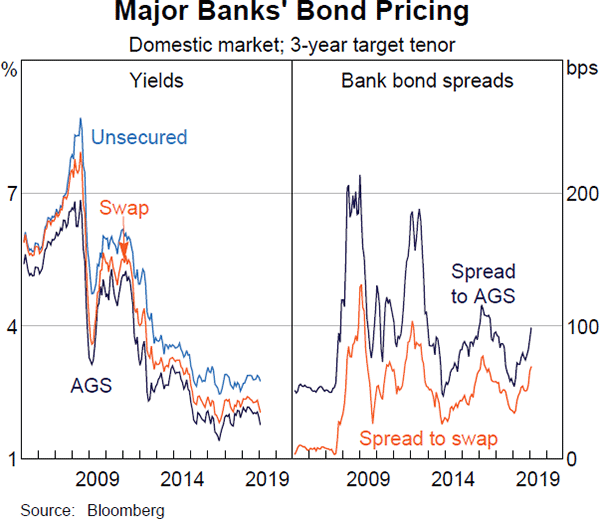
Australian banks issued a smaller volume of residential mortgage-backed securities (RMBS) in 2018 compared with 2017, driven by lower issuance by non-major banks (Graph 3.8). However, with non-bank lenders continuing to issue around $15 billion of RMBS over the year, overall issuance levels remained robust. Prices for new deals – expressed as a spread to BBSW rates – increased over 2018 from the low levels seen at the start of the year.
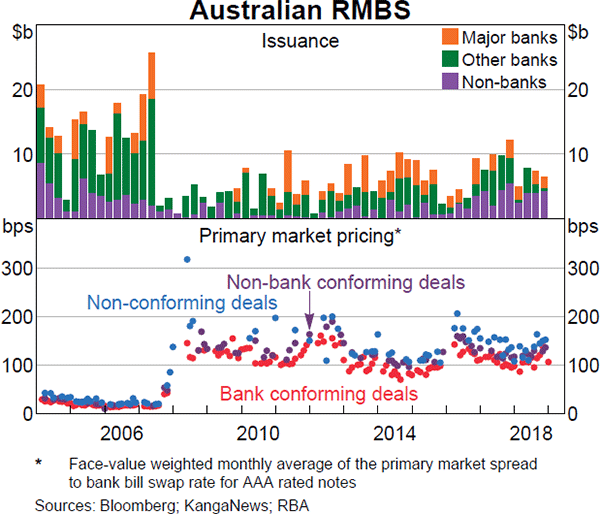
Housing lending rates have increased a little …
Most banks have increased their standard variable rates (SVRs) by around 10–15 basis points since September last year. Banks cited higher funding costs as the key reason for this change.
Data from the Reserve Bank's Securitisation Dataset suggest that outstanding variable interest rates had increased by a few basis points from the trough in August 2018 to the end of the year (Graph 3.9; Table 3.1).[2] While preliminary APRA data suggest that banks passed on some of the SVR increases to new loans in the December quarter, interest rates on new loans continue to be significantly lower than interest rates on outstanding loans. Some existing borrowers refinanced at these lower rates with a different lender or renegotiated the rate of their loan with their existing lender. Borrowers also continue to switch from interest-only to principal-and-interest (P&I) loans at lower interest rates. Consistent with these latter two factors, it appears that outstanding variable interest rates declined a little in November and December.
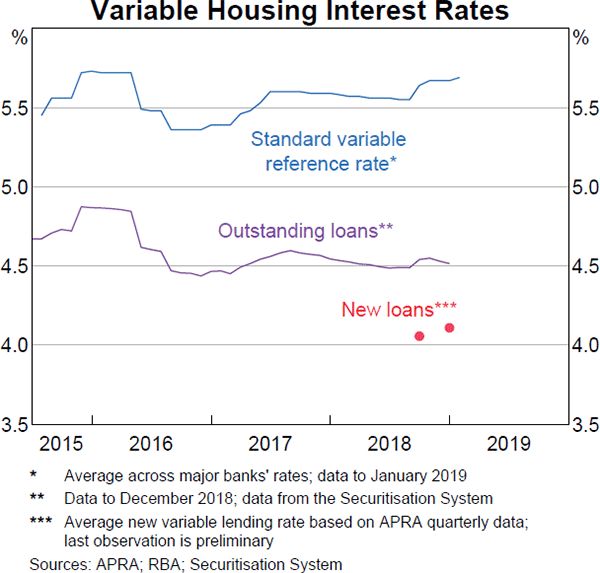
| Interest rate Per cent | Change since August 2018 Basis points | Change since December 2017 Basis points | |
|---|---|---|---|
| Variable principal-and-interest rate | |||
| – Owner-occupier | 4.28 | 3 | −1 |
| – Investor | 4.75 | 5 | 0 |
| Variable interest-only rate | |||
| – Owner-occupier | 4.79 | 7 | 5 |
| – Investor | 5.13 | 5 | 2 |
| Fixed rate | |||
| – Owner-occupier | 4.12 | −6 | −13 |
| – Investor | 4.30 | −3 | −7 |
| Average outstanding rate | 4.48 | 2 | −4 |
|
Sources: Securitisation System; RBA |
|||
… but housing lending rates remain low …
Even taking the recent increases in housing lending rates into account, these rates are at very low levels compared with history, consistent with the low level of the cash rate (Graph 3.10).
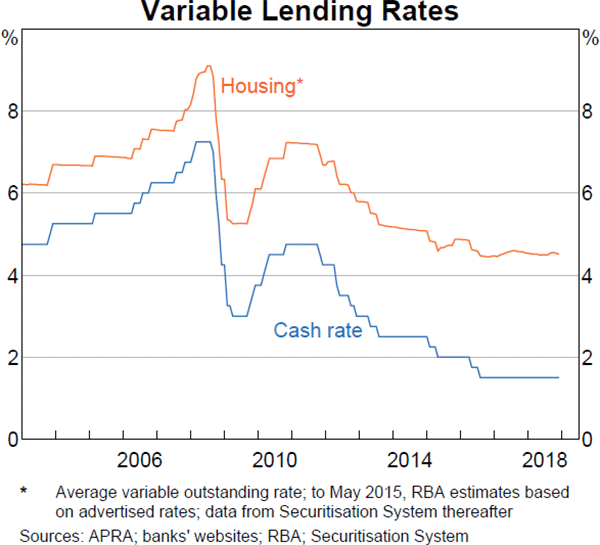
Moreover, advertised fixed rates declined throughout 2018 and are at low levels relative to history. Housing loans with fixed interest rates account for around 20 per cent of outstanding housing credit, and the rates paid on the stock of these loans adjust only gradually.
… and there is strong competition for low-risk borrowers
A number of indicators suggest that competition for new loans remains strong, particularly for low-risk borrowers. Liaison with mortgage brokers and banks suggests that lenders are competing vigorously to attract borrowers with high-quality credit profiles that are applying for owner-occupier P&I loans. In particular, owner-occupiers with low loan-to-valuation ratios who can demonstrate the ability to service their loan are being offered quite low interest rates. Liaison also suggests that borrowers with these characteristics who have had a home loan for some time and want to refinance can often obtain a lower interest rate from another institution or convince their existing lender to lower the rate that they are paying.
There is also some evidence that competition for investor loans has increased a little recently. This is particularly the case among the smaller authorised deposit-taking institutions (ADIs) that are experiencing faster investor credit growth. These lenders are among those that are offering the most competitive interest rates for new investor loans.
Housing credit growth has slowed while business credit growth has picked up
Total credit growth has remained around 4½ per cent on a six-month annualised basis since the start of 2018, with growth in housing credit moderating to 4 per cent while business credit growth picked up to 6½ per cent (Graph 3.11; Table 3.2).
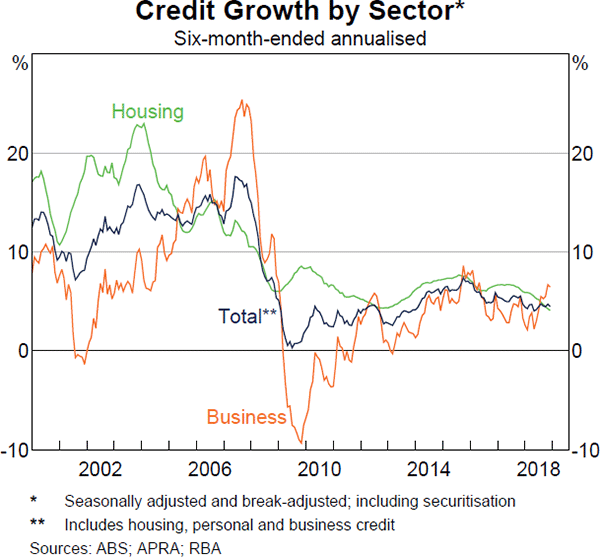
| Three-month ended annualised | Six-month ended annualised | |||
|---|---|---|---|---|
| Sep 2018 | Dec 2018 | Jun 2018 | Dec 2018 | |
| Total credit | 5.4 | 3.6 | 4.2 | 4.5 |
| – Housing | 4.7 | 3.4 | 5.3 | 4.1 |
| – Owner-occupier housing | 6.5 | 4.8 | 7.4 | 5.6 |
| – Investor housing | 1.5 | 0.6 | 1.1 | 1.0 |
| – Personal | −1.6 | −3.7 | −1.5 | −2.6 |
| – Business | 7.8 | 5.2 | 3.0 | 6.5 |
| Broad money | 3.5 | 1.2 | 2.6 | 2.3 |
|
(a) Seasonally adjusted and break-adjusted Sources: ABS; APRA; RBA |
||||
There has been a pronounced slowing in investor credit growth …
The decline in housing credit growth has been most pronounced for investors, with investor credit increasing at an annualised rate of 1 per cent over the past six months (Graph 3.12). Credit extended by the major banks to investors contracted over the period, consistent with a decline in investor housing loan approvals by these banks (Graph 3.13).
However, this had been partly offset by a pick-up in investor credit growth at a number of other ADIs and non-ADIs. These institutions only account for a small share of housing credit, but have experienced faster investor credit growth recently. In April 2018, APRA announced that ADIs could apply to be released from the 10 per cent benchmark for investor lending growth if they were able to demonstrate strong lending standards. In December 2018, APRA announced that the interest-only benchmark (of less than 30 per cent of new loans) will be removed for those ADIs that have had the investor benchmark removed.
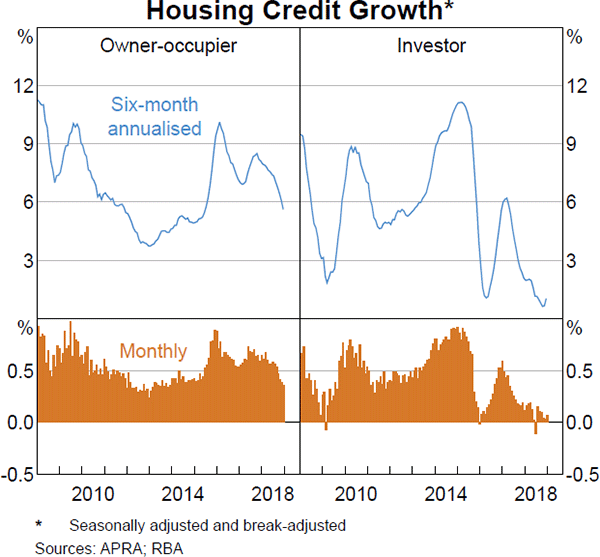
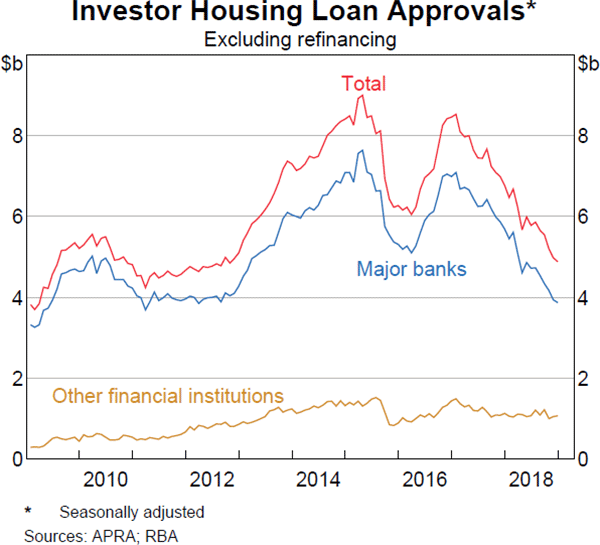
… and owner-occupier housing credit growth has also slowed
Growth in credit to owner-occupiers has eased to be around 5½ per cent in six-month-annualised terms. This has largely reflected slowing in the growth of credit extended by the major banks since mid 2017. This was consistent with a decline in approvals for new owner-occupier loans by the major banks, while their approvals for refinancing were little changed (Graph 3.14). In the past few months, both approvals and credit growth at other ADIs have eased. Estimates suggest that growth in non-ADI lending to owner-occupiers remains strong but has also eased a little recently.
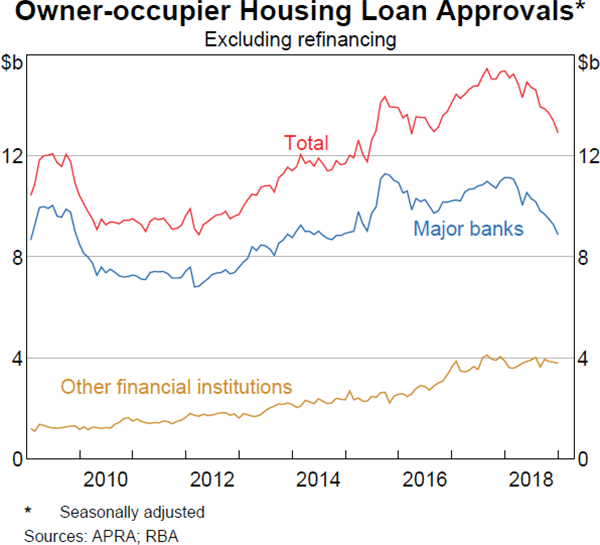
Overall, non-ADI credit growth remains strong; growth of housing credit extended by non-ADIs appears to be growing at least twice as fast as that extended by ADIs, although precise estimates of this are not possible given available data. Liaison with non-ADIs and brokers indicates that non-ADIs have been lending to borrowers who may have otherwise borrowed from ADIs if the earlier tightening in their lending criteria had not occurred.
There is less demand for housing loans
The slowing in credit growth is consistent with reduced demand for housing finance, particularly from investors. Indeed, liaison with major banks and mortgage brokers indicates that they have been receiving significantly fewer loan applications over the past year or more. Also, liaison with the banks and mortgage brokers indicates that most loans are still being approved; banks reported that the conversion rates of applications to approvals were stable at high levels in 2018. The fall in housing prices in major markets appears to have reduced the demand for credit, particularly from investors who are especially sensitive to expectations of capital losses associated with declining housing prices.
Overall housing credit conditions are tighter than they have been for some time
Housing credit conditions are tighter than they have been for some time following the improvements in lending policies and practices over recent years.[3] Over the past year, there has been ongoing work to improve lenders' assessment of potential borrowers' expenses. Lenders have also increased their focus on their responsible lending obligations. At the same time, in cases where the board of an ADI has provided assurance on the strength of its lending standards, APRA has removed the benchmarks on investor and interest-only lending, which it introduced in 2014 and 2017, respectively.
Liaison with mortgage brokers suggests that lenders are no longer making as many exceptions to their credit policies as they did in the past. Mortgage brokers also suggested that the increased public scrutiny associated with the Royal Commission into Misconduct in the Banking, Superannuation and Financial Services Industry may have led some individual loan assessors to apply criteria that are stricter than required by official lending requirements. Consequently, some borrowers who would previously have obtained a loan from the banks have been borrowing from non-ADI lenders. However, the banks report that while loan assessors are referring more approvals to credit officers, the final approval rate remains high.
With lenders now examining loan applicants' income and expenses more closely, the time taken from application to approval has lengthened slightly for some banks; the typical time from application to approval is around one week. Applicants are also declaring a higher value of expenses. This more thorough assessment of loan applicants' expenses has reduced the maximum loan size available to many households. Nevertheless, only a small share of households had previously borrowed close to the maximum amount that they were offered. Given this, even noticeable reductions in maximum loan sizes are not likely to be binding for most households.[4] Lower-income households have been more affected than others by these changes because more of these households borrow close to the maximum they are offered. Consistent with this, a number of sources suggest that average loan sizes have continued to increase over the past year, which would be consistent with a change in the composition of lending away from smaller value loans.
In summary, there is little evidence that the further tightening in lending standards over the past year or so is the main explanation for the recent decline in housing credit growth. Liaison with banks, other lenders and mortgage brokers suggests that the demand for housing loans has declined. Liaison also reported that most people who apply for a housing loan can still obtain one, though they have to provide more documentation, answer more questions and wait a few days longer to be approved.
The final report of the royal commission included recommendations about the laws relating to lending to consumers and small businesses. This should help to reduce some of the uncertainty that may have been adversely affecting the supply of credit.
Funding conditions for large businesses are accommodative …
Growth in a broad measure of business debt picked up in the second half of 2018, driven by an increase in business credit extended by banks (Graph 3.15). Much of this growth owes to lending by foreign banks operating in Australia, as has been the case for some time (Graph 3.16). Recent growth in foreign bank lending has primarily reflected their involvement in a range of large infrastructure transactions. Even so, the contribution to business credit growth by the major Australian banks has increased over the past year or so, with this pick-up occurring alongside the slower growth in their housing lending. Lending to large businesses appears to have accounted for the bulk of the growth in business credit over the same period.
The associated increase in business loan approvals can be broken down by purpose and industry. Loan approvals for the purchase of commercial property have picked up. Approvals for the construction of commercial property have also risen over the past year. In contrast, business loan approvals for residential property have declined since late 2017, particularly in NSW and Victoria. This is consistent with banks tightening their lending standards for residential property development. Loan approvals have picked up across a range of other industries in recent months including manufacturing, transport & storage, retail and mining.
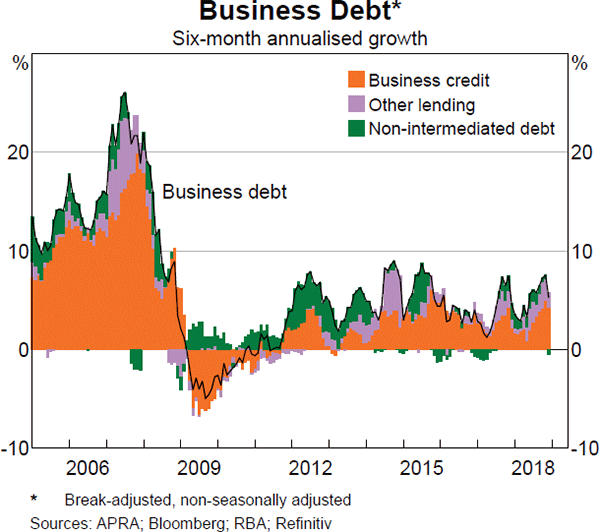
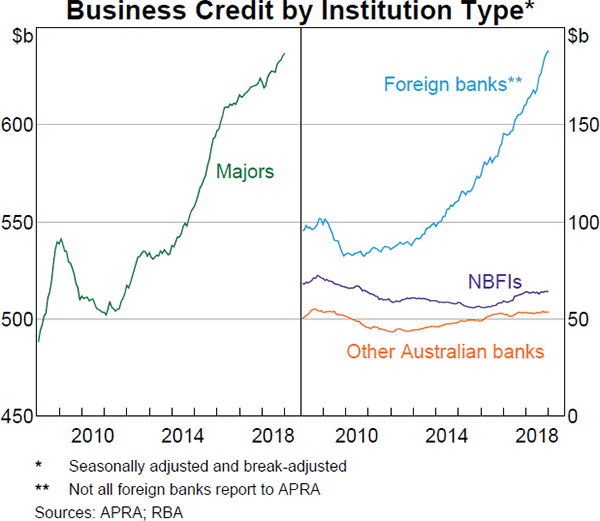
Non-financial corporations issued around $25 billion of bonds over 2018, which was just enough in aggregate to offset scheduled maturities. Notwithstanding this, funding conditions for large corporations remain accommodative, with secondary market yields remaining around historically low levels (Graph 3.17).
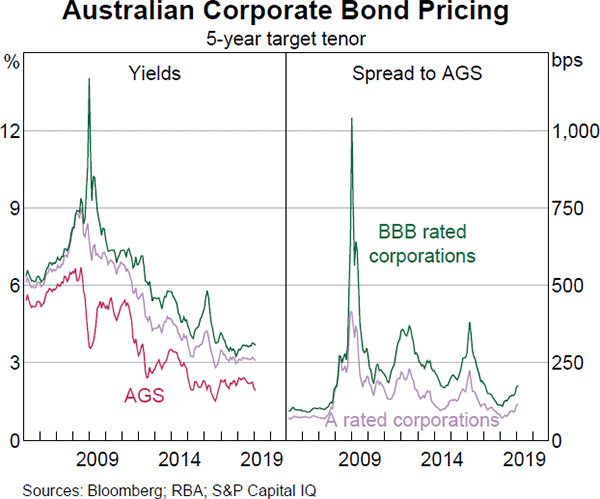
… but credit conditions for small businesses have tightened
Small businesses' perception of their access to finance deteriorated in the second half of 2018 according to business surveys (Graph 3.18). The increased scrutiny of conduct in the financial services sector associated with the royal commission appears to be weighing on lending to small businesses. Recent liaison with mortgage brokers suggests that some ADIs have responded by tightening mortgage serviceability standards for residentially secured small business loans. The distinction between the business and personal finances of entrepreneurs is often blurred. Banks appear to be applying the more onerous responsible lending rules required for consumer lending to some small business lending. Market participants have highlighted that there is a trade-off between providing protections for small business borrowers and the willingness of banks to lend. Lending to small businesses has been little changed over the past year, which is in contrast to the growth seen in lending to large businesses.
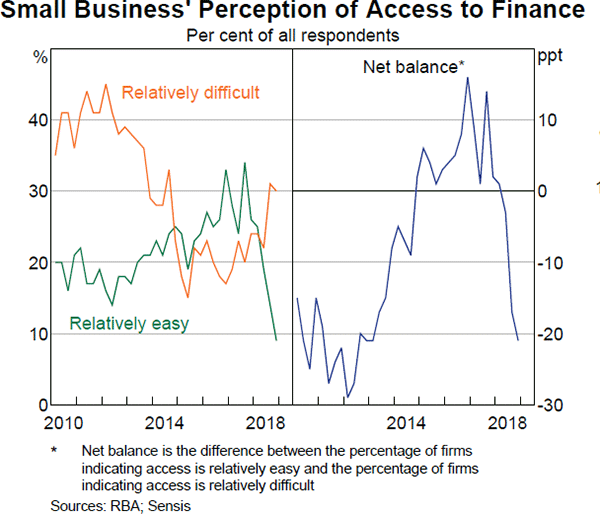
In response to the difficulties faced by many small businesses in obtaining finance, the Australian Government has announced that it would set up an Australian Business Securitisation Fund (ABSF). The ABSF would purchase asset-backed securities that are backed by loans to small businesses issued by lenders other than the major banks. The Australian Government is also encouraging the private sector to develop an Australian Business Growth Fund, similar to arrangements in the United Kingdom and Canada, to provide longer-term funding to small businesses.
Interest rates on business loans are low
Interest rates for loans to large businesses have risen over the past year, as around three-quarters of such loans are linked to BBSW rates. Rates on outstanding loans to large businesses are estimated to have increased by around 35 basis points over the past year (Graph 3.19; Table 3.3). Nevertheless, large business interest rates are still low by historical standards.
Small business rates are noticeably higher than interest rates for large businesses. Lending rates on outstanding loans to small businesses have been little changed for much of the past year, as small business rates are generally not directly linked to BBSW rates. However, some banks have increased interest rates on small business loans over the past few months, with some lenders attributing this to higher funding costs.
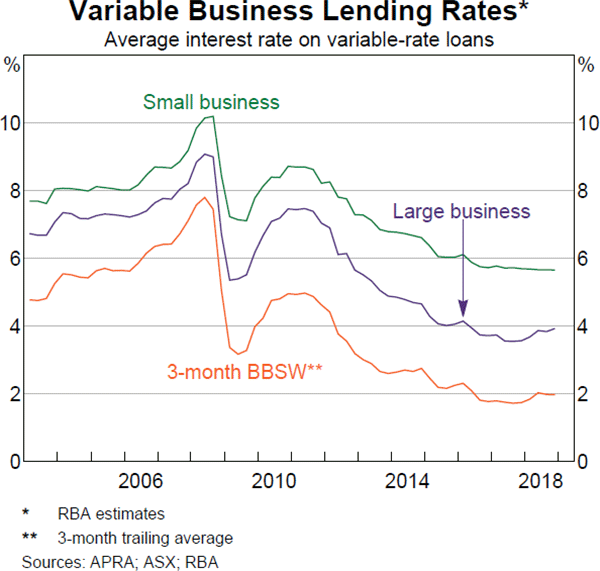
| Interest rate Per cent | Change since December 2017 Basis points | |
|---|---|---|
| Small business(a) | ||
| – Average outstanding variable rate | 5.65 | −4 |
| – Average outstanding fixed rate | 5.31 | +7 |
| Large business(b) | ||
| – Average outstanding variable rate | 3.92 | +36 |
| – Average outstanding fixed rate | 3.79 | +24 |
Australian equity prices have been more volatile of late
Volatility in Australian equity prices picked up toward the end of 2018, alongside a similar increase in volatility in global equities markets (Graph 3.20). Daily movements in Australian equity prices in recent months have exceeded the average seen over the past five years or so. The cumulative effect of these movements was a decline of 14 per cent in the Australian share market from its late August peak to its December trough. Since then, the share market has risen around 10 per cent in tandem with developments in global equities markets.
Australian equity prices are currently around their level at the beginning of 2018 (Graph 3.21). However, the accumulation index – which accounts for company dividend payments – has risen by 4 per cent over the same period. Calculating returns on this basis, the Australian equity market has underperformed the US equity market but outperformed other major global equities markets.
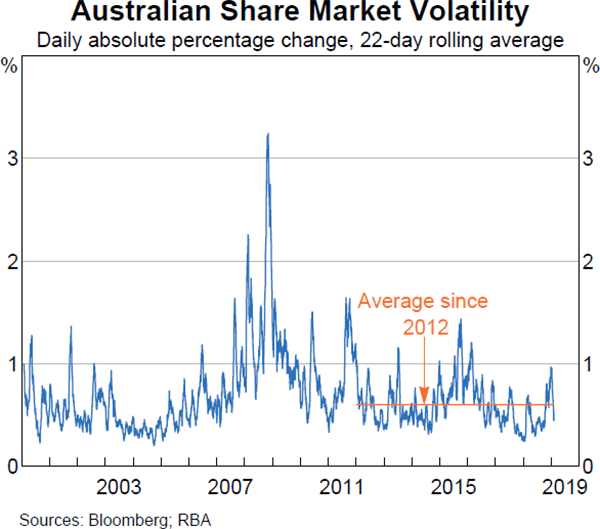
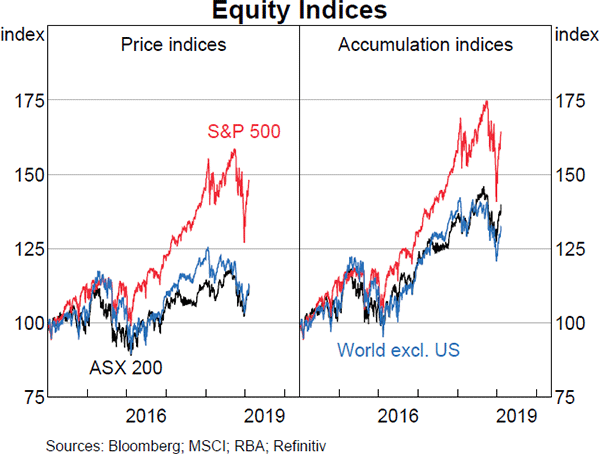
The share prices of financial corporations declined over 2018, partly in response to developments at the royal commission but also at the same time that there were falls in the share prices of financial corporations globally (Graph 3.22). While share prices of the major banks rose following the release of the final report of the royal commission, the banking sector remains around 13 per cent below its level at the start of 2018.
The resources and other sectors ended the year little changed, although there were some notable differences in performance among ‘other’ sectors. Share prices of healthcare companies increased significantly over the year, amid strong earnings expectations and mergers and acquisitions activity, while communication services stocks fell.
Price-to-earnings ratios declined in late 2018 alongside declines in share prices (Graph 3.23). Ratios for the resources and financial sectors are now below their long-run averages, although ratios for other sectors remain elevated, supported by the healthcare and information technology sectors.
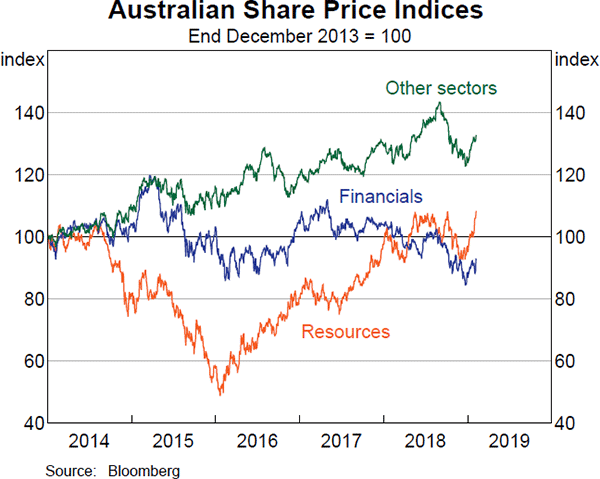
Mergers and acquisitions activity was robust in 2018, with the highest value of deals completed since the global financial crisis. Around $35 billion in deals were completed in the December quarter and potential deals worth a further $50 billion were announced (Graph 3.24).
Equity raisings by listed companies were slightly lower in 2018 than in 2017. Several initial public offerings were delayed as market volatility picked up in the second half of the year, while some businesses that had been considering listing were sold to private investors instead.
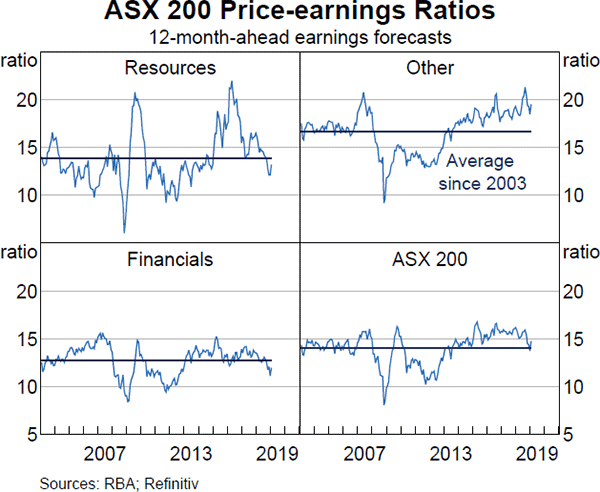
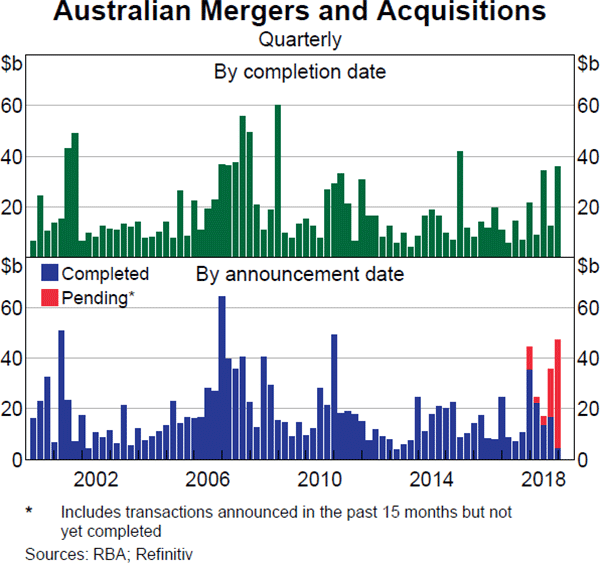
Nonetheless, capital raisings by already listed companies continued at around their usual pace, supported by a large raising by Transurban to fund its Westconnex acquisition. Share buybacks picked up late in 2018, as resource companies returned capital to shareholders in line with previously announced plans.
The Australian dollar remains within its narrow range of the past few years
The Australian dollar remains in its narrow range of the past few years on a trade-weighted (TWI) basis (Graph 3.25). Over time, movements in the Australian dollar tend to be related to developments in commodity prices (and the terms of trade more generally) and interest rate differentials. Over recent years, these two forces have been working in offsetting directions; the RBA Index of Commodity Prices has increased while Australian government bond yields have declined relative to those in major markets, particularly the United States. The net effect of these two forces has been consistent with little change in the Australian dollar.
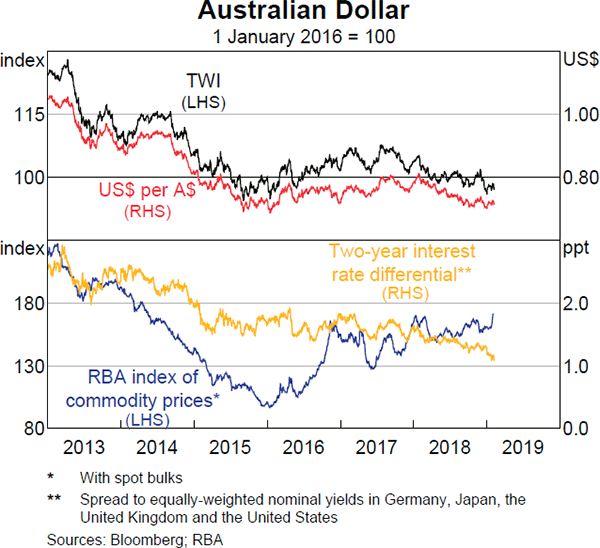
Even so, over the past few months, the Australian dollar has depreciated a little on a TWI basis. Much of the depreciation has been against the Chinese renminbi and Japanese yen, which have both appreciated against a range of currencies in recent months (see ‘The International Environment’ chapter).
As has been the case for the currencies of other advanced economies, measures of volatility in the Australian dollar remain low but have increased modestly in recent months (Graph 3.26). In early January, temporary market dislocation led to a ‘flash’ appreciation of the yen and a sharp but short-lived depreciation of the Australian dollar (see ‘Box B: The Recent Japanese Yen Flash Event’).
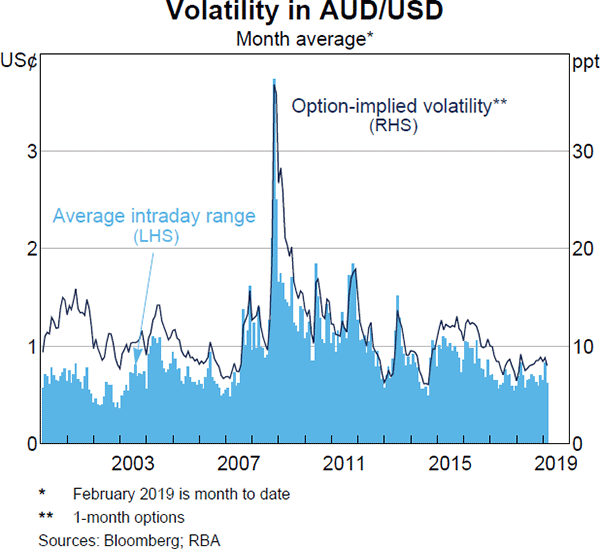
Net capital inflows to Australia continue to be modest (Graph 3.27), consistent with the relatively low level of the current account deficit. At a sectoral level, there have been increased flows of foreign investment to the non-mining corporate sector in the past few years. This has partly offset a decline in flows to the mining sector and modest outflows from the banking sector in the first half of 2018. The banking sector has continued to experience bond inflows (in line with positive net offshore bond issuance by Australian banks in the first half of 2018, although more recently this has reversed). However, these inflows have been more than offset by outflows in the form of deposits and commercial paper. This may reflect a decline in short-term Australian bank securities held by US corporations with large cash holdings, such as those in the technology sector. This is consistent with continued repatriation of funds by such corporations to the United States following tax changes there that came into effect in early 2018.
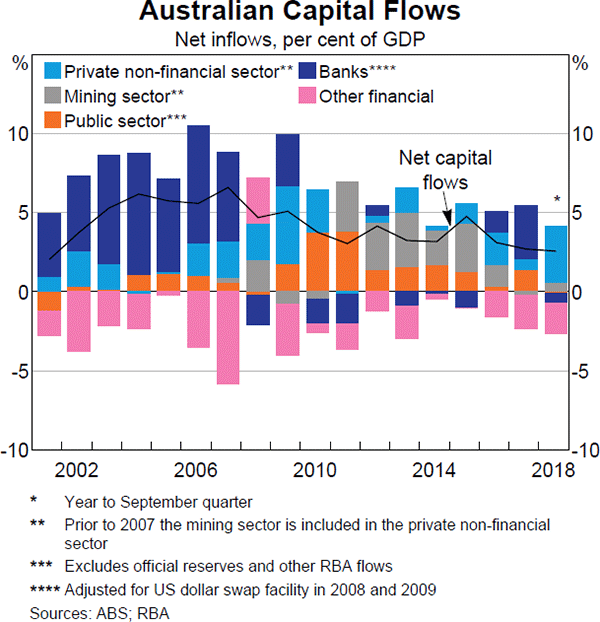
Australia's net foreign liability position has declined as a share of GDP over recent years to its lowest level since 2002 (Graph 3.28). This partly reflects a decline in net capital inflows at a time when the nominal growth of the economy has picked up. It also reflects asset valuation effects, whereby the value of Australian assets held abroad has increased relative to Australia's liabilities with the rest of the world. This is consistent with foreign equities outperforming Australian equities over the past couple of years, and the sizeable offshore equity holdings of the Australian superannuation sector. Over the past year, the depreciation of the Australian dollar has also increased the value of Australia's foreign assets (which are largely unhedged) relative to foreign liabilities (which are mostly denominated in Australian dollars or hedged against a depreciation of the Australian dollar).
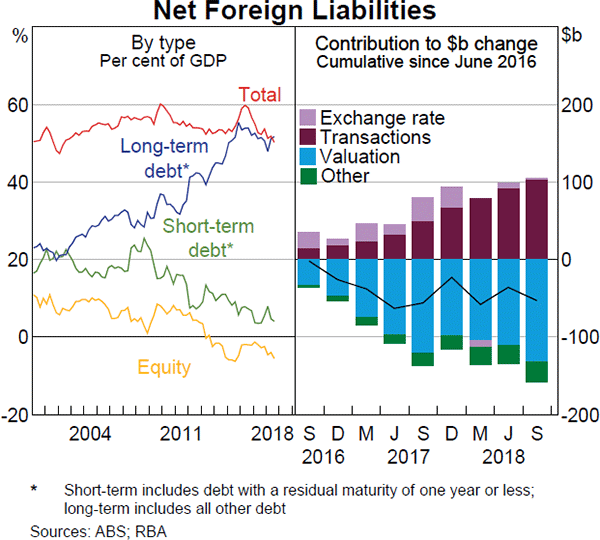
Footnotes
See APRA (2018), ‘Increasing the loss-absorbing capacity of ADIs to support orderly resolution’, Discussion Paper, November. [1]
The Securitisation Dataset covers around a quarter of the market for housing loans and includes information on the loans underlying both marketed securitisations and ADIs' self-securitisations. These data provide useful indicators of developments in home lending, although loans in the dataset may have different characteristics from those not covered by the dataset. See Fernandes K and D Jones (2018), ‘The Reserve Bank's Securitisation Dataset’, RBA Bulletin, December, viewed 7 February 2019. [2]
See RBA (2018), ‘Assessing the Effects of Housing Lending Policy Measures’, Financial Stability Review, October, pp 75–88. [3]
See RBA (2018), ‘Box B: The Impact of Lending Standards on Loan Sizes’, Financial Stability Review, October, pp 32–36. [4]